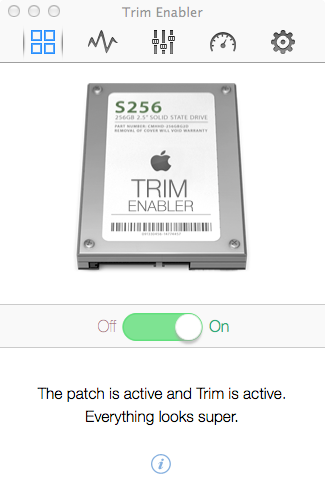

- #Samsung ssd 840 trim enabler pro
- #Samsung ssd 840 trim enabler free
- #Samsung ssd 840 trim enabler mac
- #Samsung ssd 840 trim enabler windows
However, it’s also possible that TRIM really should be enabled but something messed up in the automatic detection process. Perhaps it’s a a very old solid-state drive.
#Samsung ssd 840 trim enabler windows
If TRIM is disabled, it’s possible that Windows knows something you don’t, and TRIM shouldn’t be enabled for a drive. Windows should automatically enable TRIM if you have a modern version of Windows with a modern solid-state drive. I find this unethical, and I hope Apple change this (unlikely).If you see DisableDeleteNotify = 1, TRIM is disabled. TRIM isn’t the issue here, it’s a SATA command that is widely used and quite important, it’s just that OSX doesn't allow it to be active on third party SSD’s. So, I have to keep TRIM active under OSX Yosemite, and as frustrating as that is, it’s the only way to keep the drive snappy. In contrast to the Samsung 840 Pro, it’s performance wouldn’t drop under 350MB/s compared to the 80-120MB/s the Samsung would drop to. It’s performance dropped a little when filled and emptied a few times, and when left to idle the speeds improved a little afterwards.

On the other hand, the OCZ Vertex 4 was brilliant in a no-trim environment under heavy workloads.
#Samsung ssd 840 trim enabler pro
I’m going to keep my Samsung 840 Pro in it’s current scrambled state for another week to see if the garbage collection can bring it out of this slump a little, but I doubt that garbage collection is effective without the TRIM command to help it.
#Samsung ssd 840 trim enabler free
If I enable trim now, reboot into single-user mode, run the fsck command (this runs a TRIM free space command) and boot up normally again, the Samsung 840 Pro will regain it’s fresh state performance within a span of a few minutes of idling.

After just one week of no-trim use, the above screen-shot represent the speeds I get with the 840 Pro. It’s built in garbage collection also doesn’t noticeably improve on it’s write performance if left to idle for an entire night. Under heavy use, with a lot of writing, erasing, and filling up the volume, the Samsung 840 Pro struggles to stay fast. I have just one example for you where two different drives behave completely differently from each other in a no-trim environment. Some drives fair better than others over extended use without the TRIM command enabled, but in most cases TRIM is beneficial for the controller in maintaining drive speed and maintaining longevity of the SSD. To enable TRIM, one has to disable kext signing, which has it’s own security drawbacks, but it can also lead to a failed boot up if by some chance kext signing is reset to default again, for example by means of a p-ram reset. In OSX Mavericks, I didn’t hesitate to use TRIM enabler to assist the drives garbage collection and keep the drive fast, however this changed in Yosemite with the introduction of kext signing. In the last three months, I’ve written nearly 5TB of data to the drive. I have roughly 150 to 160GB of free space on the SSD at any given point, which in turn gets used as a Photoshop scratch disk whenever I need to do bigger projects. I use my SSD as a boot drive and scratch disk for Photoshop, so at times, the SSD needs to handle a lot of writing, and the volume fills up repeatedly at times. it was, for an OSX Yosemite environment without TRIM, a far better drive than the Samsung 840 Pro.
#Samsung ssd 840 trim enabler mac
I must admit, I should have kept my OCZ 256GB when I sold my 2012 Mac Mini. I just want to share my experiences having used both in the Mac environment, especially considering the position third party SSD owners are in with OSX Yosemite. Two years have gone by with a 256GB Samsung 840 Pro, and before it a 256GB OCZ Vertex 4.


 0 kommentar(er)
0 kommentar(er)
